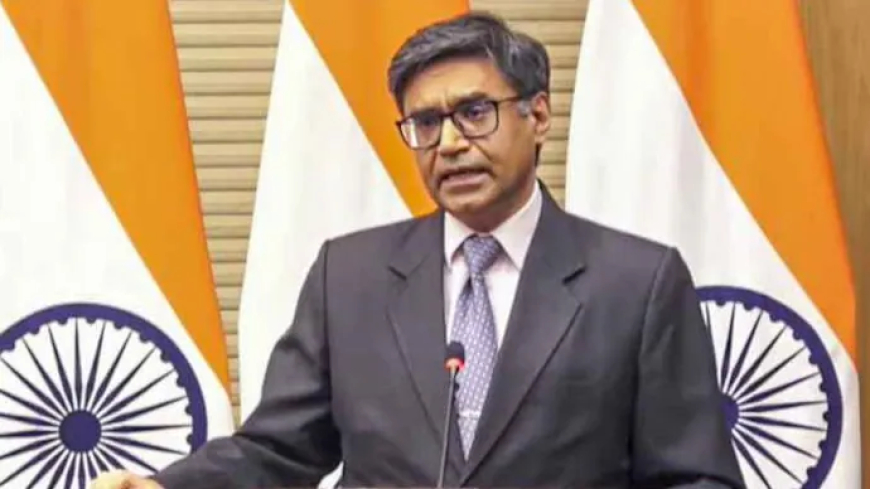Strategic Ties in Focus: Foreign Secretary Vikram Misri’s High-Stakes Visit to Washington, DC
Foreign Secretary Vikram Misri’s visit to Washington, DC, has strengthened India–U.S. strategic ties across defense, technology, and regional security. Get a detailed breakdown of the high-level meetings and key takeaways.

In a diplomatic outreach signaling the deepening strategic partnership between New Delhi and Washington, Foreign Secretary Vikram Misri concluded a pivotal visit to the United States capital this week. His meetings with top U.S. officials are seen as laying the groundwork for crucial bilateral engagements on defense cooperation, technology transfer, trade, and regional security challenges, particularly in the Indo-Pacific and South Asia.
This high-level dialogue comes at a time when India–U.S. relations are transitioning from transactional ties to a broader strategic alignment—cemented by mutual interests in countering China's assertiveness and enhancing economic synergy.
Key Highlights of the Visit
Foreign Secretary Misri held detailed consultations with senior U.S. officials, including:
-
Deputy Secretary of State Kurt Campbell
-
Under Secretary of Defense for Policy Sasha Baker
-
National Security Council Coordinator for Indo-Pacific Affairs Dr. Ely Ratner
-
Senior members of the U.S. Trade Representative (USTR) office and Department of Commerce
According to the official statement from the Indian Ministry of External Affairs (MEA), discussions focused on:
-
Strengthening Indo-U.S. defense industrial cooperation under the Initiative on Critical and Emerging Technologies (iCET)
-
Enhancing collaboration in semiconductor supply chains, AI, quantum technologies, and space
-
Deepening Quad cooperation, particularly in the maritime domain
-
Regional issues including Afghanistan, Pakistan, and China’s growing assertiveness in the Indo-Pacific
For more on iCET and its strategic implications, visit MEA’s official portal.
Why This Visit Matters Now
The visit comes at a critical juncture in global geopolitics. With the Russia-Ukraine conflict dragging on and instability looming in the Middle East, the Indo-Pacific has become the centerpiece of U.S. strategic focus. India, with its growing economic clout and robust democratic credentials, is increasingly being viewed as a cornerstone partner.
According to a report by the Center for Strategic and International Studies (CSIS), “The India-U.S. relationship is no longer defined by defense sales or student visas alone. It’s about shaping the global order.” Misri’s visit was aimed at fine-tuning this alignment, especially ahead of the upcoming 2+2 Ministerial Dialogue expected later this year.
Key Outcomes from Defense and Tech Talks
One of the most notable agenda items was operationalizing deliverables from the iCET framework announced in 2023. This includes:
-
Launching joint research centers for semiconductors and quantum computing
-
Facilitating private-sector defense production partnerships (e.g., between HAL and General Electric for jet engines)
-
Streamlining export controls and technology sharing mechanisms, long a sticking point in bilateral defense cooperation
A U.S. Department of State press release, available here, described the talks as “productive and forward-looking,” underscoring a shared commitment to creating a secure and resilient tech ecosystem.
Trade and Economic Engagement
Economic diplomacy was another central pillar of Misri’s visit. India raised concerns about trade imbalances, pending WTO cases, and visa restrictions affecting tech professionals. The U.S., meanwhile, reiterated its focus on ensuring supply chain resilience and greater market access for American firms in India.
The Federation of Indian Chambers of Commerce & Industry (FICCI) published a report prior to the visit urging both nations to streamline non-tariff barriers and co-develop green technologies. You can read the report at ficci.in.
Security Coordination in South Asia
With rising instability in the region, particularly after the Taliban takeover in Afghanistan and renewed terrorist activities near the Pakistan border, Misri's discussions with NSC officials reportedly included an exchange of intelligence assessments.
U.S. officials expressed appreciation for India’s counter-terrorism initiatives and its constructive role in ensuring regional stability. There was also a shared concern over China's influence in Nepal, Sri Lanka, and the Maldives, which may be addressed through expanded maritime domain awareness (MDA) cooperation.
Significance for the Indian Diaspora
Indian-American stakeholders welcomed Misri’s visit as a reaffirmation of diaspora diplomacy. Several think tanks, including the Carnegie Endowment for International Peace, hosted side discussions on how the Indian diaspora can support the growing India-U.S. relationship—particularly in education, science, and innovation.
Analyst Take: Beyond Symbolism
While diplomatic visits are often brushed off as symbolic, analysts argue that this one was far more strategic. Dr. Aparna Pande, a South Asia expert at the Hudson Institute, remarked:
"Foreign Secretary Misri's meetings in Washington reflect the maturity and multi-dimensional nature of Indo-U.S. ties. The momentum is irreversible, and both nations are now coordinating on everything from microchips to maritime security."
You can read Dr. Pande’s full analysis at Hudson.org.
Conclusion
Foreign Secretary Vikram Misri’s visit to Washington, DC, has reaffirmed India’s growing diplomatic weight and its indispensable role in U.S. foreign policy strategy for the Indo-Pacific. With both nations facing complex challenges ranging from tech disruption to geopolitical instability, the bilateral relationship is poised not just to endure, but to thrive—shaped by strategic intent and shared democratic values.
As India and the U.S. prepare for high-level engagements in the months ahead, this visit sets the tone for a new era of comprehensive cooperation.



















































